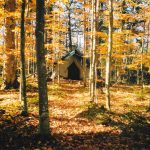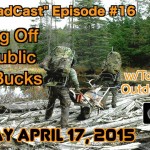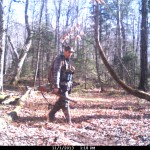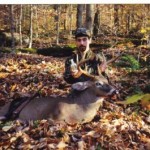It was cold when we woke up this morning. When I headed into the woods it was about 19 degrees. Fortunately, there wasn’t a lot of wind. I was exhausted today since I had to drive home last night to get my medication. I accidentally brought two infusion sets with me and forgot a reservoir. Over the years, I’ve often imagined what it would be like to hunt for one entire season without having to deal with being a Type 1 diabetic. I think it would be a lot less stressful and maybe more fulfilling. I’ve dealt with the disease to the best of my ability, but sometimes I would just like a break, like last night.
I didn’t see much sign of any wildlife today, but I enjoyed my day in the woods. Around noon, dad had a spike run out of the slash in front of where he was sitting. He figured a bigger buck might have kicked it out, but nothing else ever showed up. He sat in that place the entire day without moving. I wandered around a little bit, and during my journey I found my Cousin Kyle’s stand. I know a few years ago he said he moved it to another location, but I never really went into the area because I didn’t want to interfere with him or his plans, even though he doesn’t hunt much. I’m glad that he took the time to put a safety rope on it. It makes it so I don’t have to worry about him. When I talked to him before writing this, he told me to feel free to use his stand. I’m thinking I might have to give it a whirl one of these days. It would make my life a lot easier and cut off half of the distance I usually walk. That would be a pleasant relief, although the stand is pretty close to where my dad always sits when he hunts with me on that end of the mountain. I guess you could call it my dad’s area more than you could call it Kyle’s area. If they were both sitting there at the same time, they would surely be interfering with each other. It’s kind of neat how family members can be drawn to the same types of places.
Smitty had planned on hunting during the morning and then going home to hunt with the Hayes tomorrow in Schroon Lake. I put him in a place where I’ve seen a lot of deer over the years. He was pretty disappointed when he got a crack at a pretty decent buck. Unfortunately, he hit some brush and the bullet never made its way to the boiler maker.
Smitty hasn’t had any issues shooting since he used to hunt with us. It appeared that he had all of his issues cleared up, but I guess some of the ghosts in the closet came out to visit him today. Maybe it’s because he rejoined us like the old days. It felt great to have him back in camp with us for a few days. I wish it ended on a better note for him, but it was still fun sharing a place in the woods with one of my longtime hunting buddies whom I haven’t been able to spend much time with over the last decade.
Josh and Brian didn’t see much of anything today. Brian put on some serious miles. He always wants to explore and see new country. He did that today. I couldn’t believe how far he traveled when he showed me his tracks on his GPS. He and Josh both said they found some good sign, but not much of anything that looked fresh.
We will see what tomorrow brings. We’re supposed to get a coating of snow tonight. Maybe that will finally get the deer moving.
It was good to have Smitty back in the woods with us. Here’s a picture from when he spent a lot of time in our tent.



